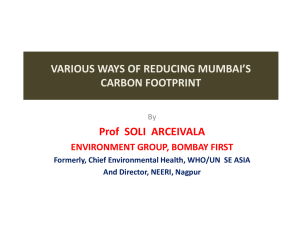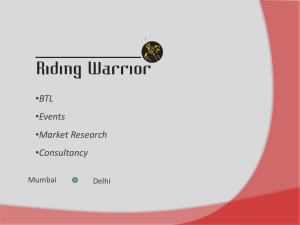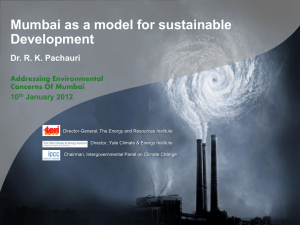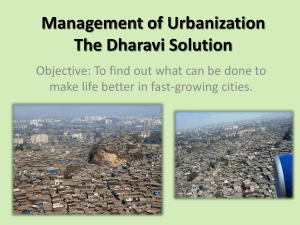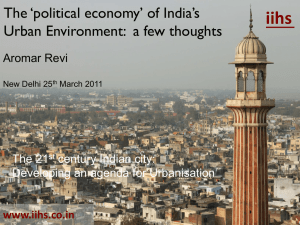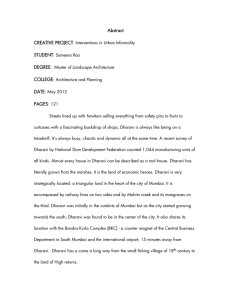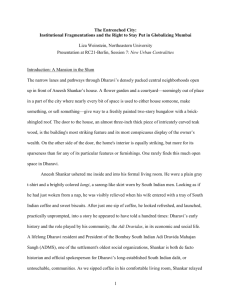Mumbai Case Study
advertisement
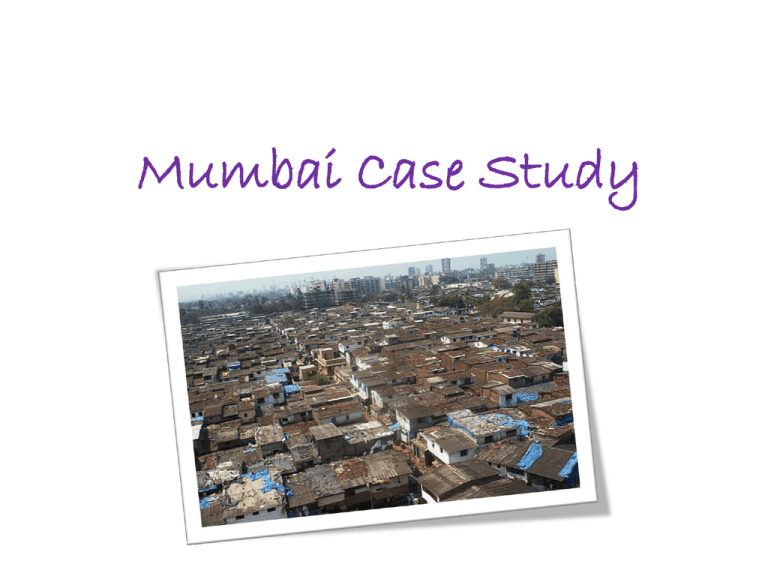
Mumbai Case Study • http://www.bbc.co.uk/learningzone/clips/an -introduction-to-mumbai-pt-1-2/4608.html Learning intentions • Site and situation • Population • Growth A Map of India & Mumbai Site and situation • Mumbai is a mega city. • Mumbai’s original site was an island off the west coast of India. • It grew as a fishing and trading port and as an industrial centre and spread on to six more islands. • The wetlands between these islands have now been reclaimed to form one island, Bombay Island. • Mumbai was originally a series of fishing villages that became a port and this is what helped encourage it’s early development. Population • http://www.census2011.co.in/census/distri ct/357-mumbai-city.html Mumbai is the world’s 4th largest city in the world. Top Ten 1. Shanghai 2. Istanbul 3. Karachi 4. Mumbai 5. Moscow 6. Sao Paulo 7. Beijing 8. Tianjin 9. Guangzhou 10. Delhi Causes of urban growth • Until the 1980’s, the economy was based mainly on textile manufacturing and shipping with there still being a major port there today. • There’s been an increase in IT and financial services recently. • Mumbai is a major centre for out-sourced work – companies there work for foreign companies. • Mumbai is a major media centre for India and is one of the largest in the world. Causes of urban growth… • A rapid amount of people are drawn in from the countryside due to work being so varied from highly skilled jobs to practical work and people believe they will have better life chances in the city. • Travellers from Europe used the ports that became known as “The gateway to India”. The area around the port became industrialised as a result and became used for importing and exporting goods. • A variety of services grew around the port and this led the city to grow during British rule, and even more rapidly when British rule had left in 1947. • Banking, finance and insurance that were associated with the ports allowed Mumbai to become a major source of finance. This enabled Mumbai’s economy to grow and is allowing it to become a world city. Mumbai’s CBD Learning intentions To learn about the features of the CBD in Mumbai - Shopping - Offices - Transport Starter question…? What would you expect to find in the CBD of a city and why – take 5 minutes to discuss with your group. e.g. The CBD will have the oldest buildings because it contains the oldest area of the city. Shopping http://www.tes.co.uk/teaching-resource/An-introduction-to-Mumbai-pt2-2-6185593/ Shopping malls Covered and air-conditioned Sell mostly high-order goods Assured quality of goods An orderly and clean environment Sell goods for a fixed price Pay by cash or credit card Street markets Open air Sell a huge range of goods Quality of goods variable Noisy and crowded environment Lower prices, but need to haggle Pay by cash only Offices Mumbai is the biggest financial and commercial centre in India. The main office district in the CBD is on reclaimed land at Nariman point. Why does the CBD attract so many offices? Transport Building transport in Mumbai has become more difficult because of the site of Mumbai: • It was originally on several islands, so causeway and bridges have had to be built. • Bombay Island itself is narrow, so there is little space for roads and railways. • The CBD is at the southern tip of the island so it can only be accessed from the north. Mumbai has two main strategies for dealing with this problem: It set up the Urban Transport Project in 2002, which is using four methods to solve traffic congestion: • Improve railways – more tracks, more stations • Improve roads – new road links between the main highways, widen some roads up to six lanes • More buses – 500 new eco-buses • Speed up road traffic – flyovers instead of intersections, subways instead of pedestrian crossings. • In 1979, building started on a new town (called New Bombay) on the mainland opposite Mumbai. This should grow into a large city, with its own shops, services and jobs, which should reduce the number of people travelling into the centre of Mumbai. Learning intentions • Factors causing people to move from rural to urban areas • Housing in the suburbs LEDC: MIGRATION FROM THE COUNTRYSIDE TO THE CITY The movement of people from the countryside into cities is called rural to urban migration. People move for two reasons. Firstly they may wish to get away from things they do not like, these are called push factors. Secondly, people are attracted to things that they do like, these are called pull factors. Look at the following photographs, what causes people to move from the countryside to the city? RURAL PUSH FACTORS • LOW WAGES & FEW PAID JOBS • POOR HOUSING WITH NO RUNNING WATER OR ELECTRICITY • LACK OF SCHOOLS & HOSPITALS • SOMETIMES CROPS FAIL URBAN PULL FACTORS • BETTER PAID JOB • CHANCE FOR THE CHILDREN TO GO TO SCHOOL • DECENT HOUSE • HEALTH CARE • • • • • • 400,000 square feet (37,000 m2) of living space. parking space for 168 cars. a one-floor vehicle maintenance facility. nine elevators in the lobby three helipads and an air traffic control facility health spa, yoga studio, small theatre with a seating capacity for 50 on the eighth floor,14 swimming pools, three floors of hanging gardens, and a ballroom. • an ice room infused with man-made snow flurries. • Cost $2 billion • 600 full time staff • Antilia is the name of a twenty-seven floor personal home in South Mumbai belonging to businessman Mukesh Ambani the billionaire Chairman of Reliance Industries • Look at the following slides, what are the problems found in Dharavi? Problems caused by urban growth… • Problems with health occur due to pollution from within the shanty towns and heavy industry causes air pollution that also contributes to poor health. • Widespread poverty and unemployment due to so many moving to the area and the high birth-rate means there isn’t enough employment. • Poor education leads to people being unemployed as they haven’t the skills and knowledge needed and too many people mean that schools and public services can’t deal with the amount of people. • Land value in Mumbai is expensive due to there being little land so it makes it impossible for those living in shanty towns to afford homes. This results with people living in illegal shanty towns that increase the health problems due to them being so cramped. • Asia’s second largest slum is Dharavi and is home to 800,000 people which has cheap, poorly made housing. • Poor transport links as they are so busy and cramped with commuters as there are so many living within the city. • Pollution increases due to those living in the shanty towns. Solutions… • In 1970 a plan was introduced to move the port, markets and industrial functions out of the old city to Navi Bombay on the east. The idea was to also move workers too. The plan was partially successful but the problem in Dharavi had to be sorted. • More than 600,000 live in Dharavi (next to the CBD), and the idea was to move the housing and people will be rehoused into temporary accommodation. • The two storey homes will be replaced by seven storey so that it can house more people. Those who can prove they have been living in Dharavi since 1995 will receive free accommodation • The new buildings will have to have infrastructure including roads, water, drainage, schools, industrial estate etc. Solutions (cont.)… • However, the project can not go ahead unless the majority of the registered residents in the shanty town agree. However, the unregistered people will have their views ignored • Governments and developers have used underhand tactics to make people sign the agreements. • There are fears amongst the people that the government won’t actually build alternative accommodation but instead will be replaced with higher value developments for businesses and companies to allow the city to continue to expand. Sample answer In the 1970s the Government of India began plans to create a new city, Navi Mumbai, to move many of the residents from Dharavi. Part of Dharavi where residents had been evicted had the houses bulldozed. This new town had better services and amenities. The two storey houses were made into seven storeys to house more people. They were made of brick to be more secure. continued In Dharavi itself some self help schemes have been put in place. This is where the authority provide building materials for the residents to enable them to build the houses themselves. They also provide areas with electricity and sanitation.

